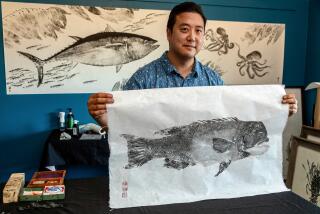Scrimshaw Artist Keeps Whaling Tradition Alive
- Share via
The masthead lookout kept vigil for the spout of a whale, while the little wooden bark from New Bedford, its sails drawing well, rolled over the easy swells of the South Pacific.
There was activity on board, but not of a kind that filled casks with oil. The men were busy scrimshawing, an activity that passed the time between long stretches at sea when there was no catching and trying out whales.
Scrimshaw was a form of art practiced on American whalers, particularly during what is termed the golden era of whaling from 1825 to 1865. Scrimshawing was generally the act of scratching or engraving on bone, largely the teeth of sperm whales, various decorations and scenes. When the design was incised, color was added--India ink, paint, soot, tar, dyes. Excess color was wiped off, leaving the picture sharp and defined.
Scrimshaw, says Don Taylor of the New Bedford Whale Co. of Newport Beach, is a true American folk art. Taylor has been scrimshawing since he was 7 years old. At 39, he is among a handful of artists in the nation keeping the old art alive and, it seems, the only one in the local area to pursue it as a full-time enterprise.
Simulated Ivory
Taylor, now involved in the “Green Peace” movement to preserve and protect whales, refuses to scrimshaw on real whale bone, ivory and walrus tusks. He practices his art today on simulated ivory cast from a formula of polymers and powdered vegetable ivory. When he completes preparing, coloring and polishing, only an expert eye can differentiate between the real thing and Taylor’s simulation. It even feels cool to the touch, like genuine ivory.
Taylor is downright mystical about whales, old vessels sailing beneath great clouds of canvas and scrimshawing. He would be at his happiest scrimshawing portraits of ships while aboard old sailing vessels, such as the Star of India. In fact, he is donating to the Orange County Marine Institute at Dana Point Harbor, owners of the bark Pilgrim II, a piece of scrimshaw he’ll carve aboard the vessel. He plans to complete the piece sometime in August.
It is this linkage, this communion with the past through his beloved art, that inspired Taylor to compose a small poem about his feelings. He calls it simply “Whales.”
If man would only close his eyes to greed
And let him gaze upon the sea, for the sea holds
The eternal flame of man’s existence,
And at the tip of the flame burns the cry for harmony,
Which only can be heard by those of us who know
The great scholars of the deep, the Whales.
While spending several summers in New Bedford as a boy, Taylor met Captain Jack, an old sailor, whom he believed to be “older than God.” Captain Jack taught him to scrimshaw, simple little pieces scratched into fragments of bone with a penknife or sail needle and sold to tourists for 30 cents each. The old mariner filled him with romantic stories of the sea and also gave him the name that Taylor signs on his mature work--William Pedit Shaw.
To this day, Taylor has no idea who William Pedit Shaw was. He thinks perhaps that Captain Jack simply made it up on the spot. “He just told me that’s who I should be,” says Taylor.
At Sea or on Shore
Taylor has added a new word to my vocabulary--”Scrimshore.” It is used to differentiate between scrimshaw done at sea and that done on shore.
We discussed the origin of the word. It is said to have been derived from skrimshander, squimshon, scrimhorn, all meaning to work on bone or ivory. Some say the word came from the American Indian, from the Dutch, from the South Pacific. It has never been positively settled, except that it became the folk art of the American whalers.
And that Don Taylor, a.k.a. William Pedit Shaw, a self-taught draftsman, like his whaling forebears, is carrying on the tradition in fine, sensitive style.


